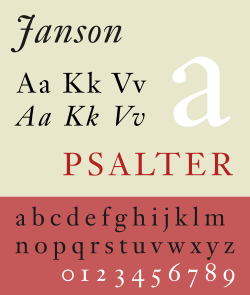Janson
 | |
| Category | Serif |
|---|---|
| Designer(s) | Chauncey H. Griffith |
| Foundry | Linotype |
| Design based on | Nicholas Kis' Roman of 1685 |
Janson is an old-style serif typeface named for Dutch punch-cutter and printer Anton Janson (1620–1687). Research in the 1970s and early 1980s, however, concluded that the typeface was the work of a Hungarian punch-cutter, Miklós (Nicholas) Tótfalusi Kis (1650–1702). Tótfalusi Kis traveled to Amsterdam in 1680 to serve as an apprentice under Dirk Voskens; he and cut several typeface while working under Voskens, producing a roman-text face about 1685 upon which present-day Janson is based. Tótfalusi Kis also cut Greek and Hebrew typefaces, both for use in printing Polyglot Bibles. Janson shows strong influence of the Dutch Baroque typefaces.
A revival of the face was designed in 1937 by Chauncey H. Griffith of the Mergenthaler Linotype foundry. The revival was taken from the original matrices, held since 1919 by the Stempel Foundry, Mergenthaler's exclusive agent in Europe.
The most common digital version, Janson Text, comes from a metal version produced by Hermann Zapf in the 1950s at Stemple, based on Kis' original matrices.[1]
Despite its 17th-century origins, Janson is used in a wide variety of contemporary text applications. As of the magazine's 2011 redesign, Architectural Digest uses Janson for body text in all of its articles.
References
- Carter, Rob, Day, Ben, Meggs,Philip. Typographic Design: Form and Communication, Second Edition. Van Nostrand Reinhold, Inc: 1993 ISBN 0-442-00759-0.
- Lawson, Alexander S., Anatomy of a Typeface. Godine: 1990. ISBN 978-0-87923-333-4.
- Molnár, József. Misztótfalusi Kis Miklós. Európai Protestáns Szabadegyetem: 2000. ISBN 963-506-329-6.
- Middendorp, Jan. Dutch Type. 010 Publishers: 2004. ISBN 90-6540-460-1 .
- Updike, Daniel Berkeley. Printing Types Their History, Forms and Use. Dover Publications, Inc: 1937, 1980. ISBN 0-486-23929-2.
- Jaspert, W. Pincus, W. Turner Berry and A.F. Johnson. The Encyclopedia of Type Faces. Blandford Press Lts.: 1953, 1983. ISBN 0-7137-1347-X.
- ↑ Jaspert, Pincus, Berry, and Johnson, p. 122.